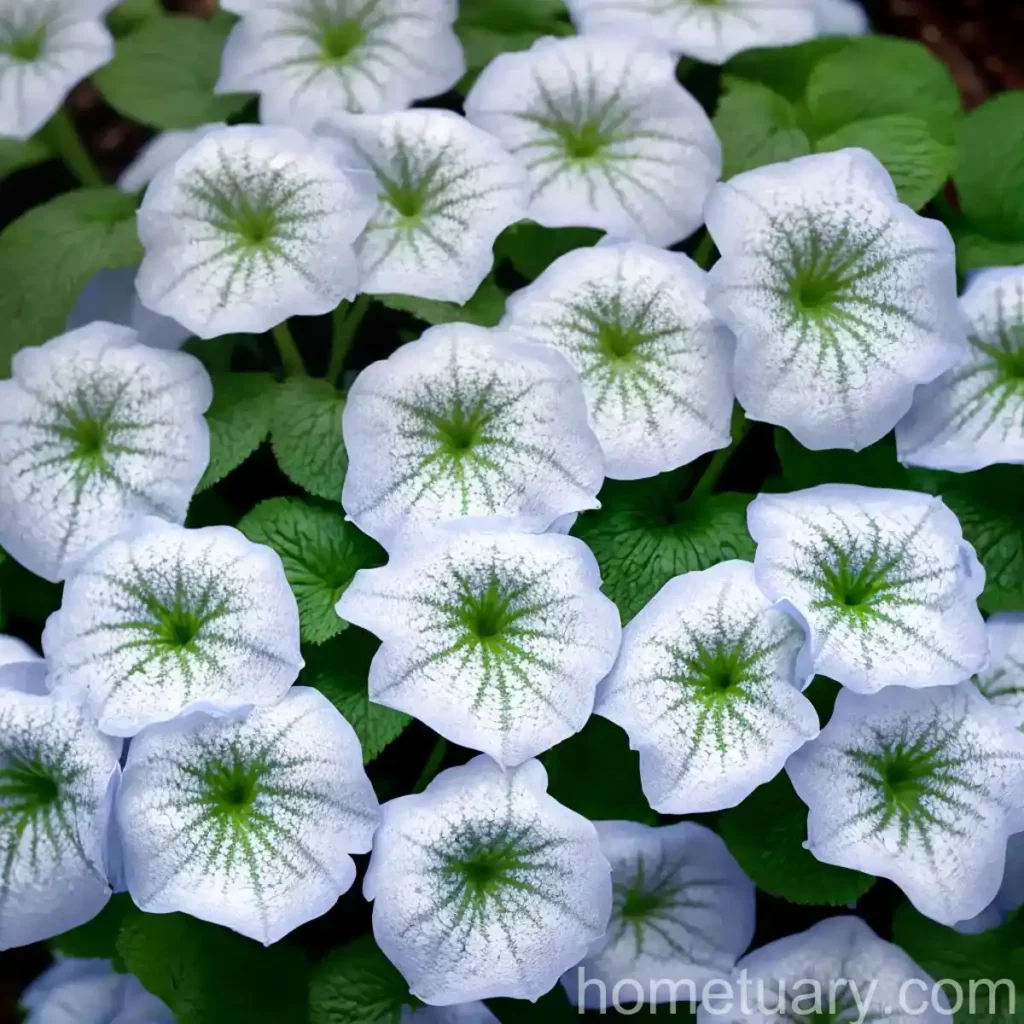Siberian Bugloss (Brunnera macrophylla ‘Dawson’s White’)
Siberian bugloss, scientifically known as Brunnera macrophylla ‘Dawson’s White’, is a charming perennial plant that belongs to the family Boraginaceae. This delightful plant is a favorite among gardeners for its beautiful foliage, delicate flowers, and easy cultivation. In this comprehensive guide, we will explore the culture, uses, maintenance, and fascinating characteristics of the Siberian bugloss. Whether you are a seasoned gardener or a beginner looking to enhance your green space, this article provides a wealth of information about the versatile and enchanting Siberian bugloss.
Table of Contents
- What is Siberian Bugloss?
- Key Takeaways
- Culture
- Uses
- Water
- Sunlight
- Fertilizer
- Soil
- Pruning
- Propagation
- Container Popularity
- Common Diseases
- Disease Diagnosis
- Common Pests
- Botanist’s Tips
- Fun Facts
- Links to External Resources
1. What is Siberian Bugloss?
Siberian bugloss, also known as false forget-me-not, heartleaf, or Brunnera, is a perennial herbaceous plant native to Eastern Europe and Western Asia. It is part of the Boraginaceae family, which also includes the renowned forget-me-nots, and shares some resemblance to Myosotis species.
The Siberian bugloss is prized for its heart-shaped leaves and small, delicate flowers, which bloom in early to mid-spring. The ‘Dawson’s White’ cultivar, in particular, is known for its striking silver-green foliage adorned with delicate white flowers, creating a mesmerizing display in shady areas of the garden.
2. Key Takeaways
Before delving into the specific aspects of the Siberian bugloss, let’s outline the key takeaways for easy reference:
- Siberian bugloss is a perennial herbaceous plant with heart-shaped leaves and delicate white flowers.
- The ‘Dawson’s White’ cultivar is particularly striking, featuring silver-green foliage.
- It is well-suited for shady areas and is a popular choice for woodland gardens.
- Siberian bugloss is low-maintenance and adapts well to various environmental conditions, making it an excellent choice for beginner gardeners.
- The plant is versatile and can be used in borders, containers, or as ground cover.
3. Culture
Planting Tips
- Siberian bugloss thrives in organically rich, moist, and well-drained soils.
- Plant in partial to full shade for optimal growth.
- When planting multiple specimens, space them approximately 18 to 24 inches apart to allow for sufficient air circulation and expansion.
Ideal Growing Conditions
- The plant prefers cool, shaded areas but can tolerate some morning sun.
- In regions with hot summers, providing dappled shade or filtered sunlight can prevent the foliage from scorching.
Hardiness Zones
- Siberian bugloss is well-suited for USDA hardiness zones 3 to 8.
4. Uses
Ornamental Value
- The Siberian bugloss is primarily cultivated for its ornamental attributes, including its attractive foliage and delicate blooms.
- The ‘Dawson’s White’ cultivar, with its elegant silver-green leaves, adds a touch of sophistication to any garden setting.
Ground Cover
- Due to its spreading habit, Brunnera macrophylla is often used as ground cover in shaded areas.
Woodland Gardens
- This charming plant flourishes in woodland or shaded garden settings, contributing to a natural and serene ambiance.
5. Water
Watering Needs
- Siberian bugloss thrives in consistently moist soil. Regular watering, especially during dry periods, is essential to maintain optimal growth and prevent stress to the plant.
- However, it is important to avoid waterlogged conditions, as excessive moisture can lead to root rot and other problems.
Soil Moisture
- Aim to keep the soil evenly moist, but not saturated. Applying a layer of mulch around the base of the plant can help retain moisture and prevent rapid evaporation.
6. Sunlight
Light Requirements
- Siberian bugloss is well-adapted to partial to full shade conditions.
- While it can tolerate some morning sun, it generally prefers the cool, dappled light found in woodland settings.
Sun Exposure
- Protecting the plant from intense midday sun is crucial, especially in regions with hot summers. Providing shelter or planting near larger trees can offer the necessary shade.
7. Fertilizer
Nutrient Needs
- The plant benefits from a balanced, slow-release fertilizer in early spring to support healthy growth and vibrant foliage.
- Alternatively, amending the soil with organic matter such as compost can provide essential nutrients and improve soil structure.
8. Soil
Soil Type
- Siberian bugloss thrives in organically rich, well-draining soil. Loamy soils with good water retention properties are ideal for sustaining healthy growth.
pH Range
- The plant tolerates a slightly acidic to neutral soil pH range, typically between 6.0 and 7.5.
Soil Amendments
- Incorporating organic matter, such as compost or well-aged manure, into the soil can enhance its structure and fertility, supporting the long-term health of the plant.
9. Pruning
Pruning Technique
- Remove spent flower stems to encourage additional blooms and maintain a tidy appearance.
- In late fall or early spring, prune back any damaged or discolored foliage to promote fresh growth.
Maintenance
- The Siberian bugloss is low-maintenance and generally requires minimal pruning. However, periodic removal of dead or yellowing leaves can help improve the plant’s overall appearance.
10. Propagation
Propagation Methods
- Siberian bugloss can be propagated through division or by collecting seeds.
- Division is typically carried out in early spring, while collecting seeds is done after the plant has finished flowering.
Division Tips
- When dividing the plant, ensure that each division has a sufficient number of healthy roots to support its growth.
11. Container Popularity
Container Planting
- Siberian bugloss can thrive in containers, making it a versatile choice for patios, balconies, or small gardens.
- When planting in containers, select a well-draining potting mix and ensure adequate moisture levels without waterlogging the roots.
12. Common Diseases
Disease Resistance
- Siberian bugloss is generally resistant to most common diseases, making it a reliable and low-maintenance addition to the garden.
Disease Susceptibility
- While it is resilient to many diseases, the plant can occasionally experience issues such as powdery mildew or leaf spot, especially in humid or overcrowded conditions.
13. Disease Diagnosis
Identifying Issues
- Keep an eye out for signs of discoloration, unusual spots, or wilting foliage, which can indicate potential disease or pest problems.
- Promptly address any issues to prevent the spread of diseases and maintain the plant’s overall health.
14. Common Pests
Pest Resilience
- Siberian bugloss is relatively resistant to pest infestations, thanks to its vigorous growth and natural defenses.
Potential Pests
- Occasionally, the plant may attract slugs, snails, or aphids, particularly in humid or sheltered environments.
- Employing preventive measures, such as physical barriers or organic pest control methods, can help safeguard the plant from potential infestations.
15. Botanist’s Tips
Expert Recommendations
- When selecting a planting site, prioritize well-drained, organically rich soil and partial to full shade conditions.
- Regular monitoring and prompt attention to watering needs can help maintain the plant’s health and vibrancy.
16. Fun Facts
Intriguing Tidbits
- The silver-green foliage of ‘Dawson’s White’ Brunnera macrophylla lends itself to stunning visual contrasts in shade gardens.
- Siberian bugloss is also known for its deer resistance, making it an excellent choice for landscapes frequented by wildlife.
17. Links to External Resources
Further Reading
- Royal Horticultural Society – Brunnera macrophylla
- University of Wisconsin-Madison Master Gardener Program – Brunnera macrophylla ‘Dawson’s White’
- The Spruce – How to Grow and Care for Siberian Bugloss
In conclusion, Siberian bugloss (Brunnera macrophylla ‘Dawson’s White’) is a captivating perennial plant with a myriad of uses, from ornamental adornment to ground cover in shaded areas. Its low-maintenance nature, enchanting foliage, and delicate flowers make it a prized addition to any garden. By understanding its cultural requirements, maintenance needs, and potential applications, gardeners can harness the full potential of this exquisite plant, enhancing the beauty and diversity of their outdoor spaces.
Whether you’re seeking a resilient and alluring plant for a shaded border, woodland garden, or container display, the Siberian bugloss stands out as a versatile and enduring choice, providing year-round interest and charm. With its captivating foliage and ethereal blooms, this perennial gem continues to captivate the hearts of garden enthusiasts and botanical admirers alike.















